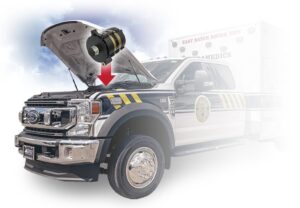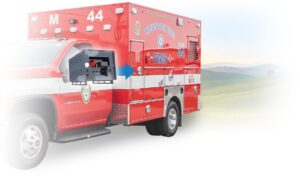There’s no one-size-fits-all solution when it comes to powering emergency vehicles like ambulances. Every fleet manager faces the challenge of balancing cost, maintenance, and environmental impact. Emergency Transportation Associates (ETA) is dedicated to aiding you in your analysis of power option comparisons, providing valuable insights to facilitate informed decision-making.
Frazer Ambulance Power Options
Frazer offers three power options that vary widely, each with distinct advantages. The MEPS System utilizes engine-mounted generators for reliable power with low maintenance. The Onan Generator offers independent power sources for fail-safe operation and extended vehicle lifespan. Harrison Hydragen’s hPower manages idle mitigation and battery charge for fuel savings and environmental benefits. Understanding these differences will help meet your specific needs, ensuring optimal performance, longevity, and efficiency for every operation with this diverse array of emergency vehicle power options.
 MEPS: Under-Hood Generator
MEPS: Under-Hood Generator
The MEPS System uses an engine-mounted generator to produce 120V AC power, requiring the truck chassis to be operational. It provides reliability, durability, and low maintenance, making it an excellent choice for cost-effective solutions with increased storage space.
ONAN: Independent Generator
The Onan Generator functions as a standalone power source, separate from the chassis engine. It offers fail-safe power, quiet operation, and quick swap-out capability, which is ideal for extending the lifespan of truck chassis through idle reduction.
 hPOWER: Lithium Ion Battery Pack System
hPOWER: Lithium Ion Battery Pack System
Harrison Hydragen’s hPower system operates through an inverter-lithium ion battery pack system. It smartly switches between idle mitigation and battery charge, reducing fuel costs and excessive engine wear and promoting environmental cleanliness.
MEPS PMI: Power Management Interface
MEPS PMI features idle-reducing technology, enabling the under-hood generator system to power onboard electrical equipment while replenishing battery banks. It ensures continuous mobile electric power, reducing chassis wear and tear, fuel consumption, and idle time.
Power Option Comparative Analysis
A side-by-side comparison of power options for emergency transportation vehicles provides a clearer picture:
Feature |
Onan |
MEPS |
hPower |
MEPS PMI |
Independent from Chassis |
Yes | No | *Yes | *Yes |
Engine Dependency |
Yes | No | *Yes | *Yes |
Idle Reduction |
Yes | No | Yes | Yes |
Upfront Cost |
$11,000.00 | $16,500.00 | $39,000 – $49,000 (Dependent on number of batteries) | $35,000.00 |
Spare Equipment Cost |
$5,350.00 | $2,600.00 | $0 | $2,600.00 |
Annual Fuel Cost |
$4,850.00 | Negligible | 40-50% reduction per year | 40-50% reduction per year |
Annual Maintenance Cost |
$1,000.00 | Approx. $400.00 | $0 | Approx. $400.00 |
Further Power Option Comparison:
Battery Systems & Idle Reduction
Idle reduction technology intelligently switches between generator and battery power.
Feature |
hPower |
MEPS PMI |
Battery Capacity Options |
8.4 kWh or 12.7 kWh | 8.4 kWh |
Number of Batteries |
s2 + (Dependent on Space) | 2 + (Dependent on Space) |
Battery Run Time |
2-4 Hours | 1 1/2 – 2 Hours |
System Startup |
Automatic | Automatic |
Battery Voltage |
12V | 24V |
Battery Amperage |
660-990 Ah | 300 Ah |
Inverter |
5000W 12V-Sine Wave | 5000W 12V-Sine Wave |
Display |
Cerbo Touchscreen | Color Control Button |
ACU Heat |
No Heat | ACU Heat |
Alternators |
No Extra Alternators | 3rd Alternator |
Cooling |
Thermatically Controlled | Constant Fan Pulling AC |
Temperature Monitoring |
Yes | No |
Extra Belts |
No | Extra Belt Line |
Cutting Hoses/Lines |
No Cutting or Moving | Cutting Hoses/Lines |
Understanding the distinctions of each power option is necessary for making informed decisions. Whether prioritizing cost, maintenance, or environmental impact, Emergency Transportation Associates (ETA) can guide you toward the best solution. Choose wisely to ensure the efficiency and reliability of your ambulance fleet.
Power Option Videos by Frazer
|
|
|

